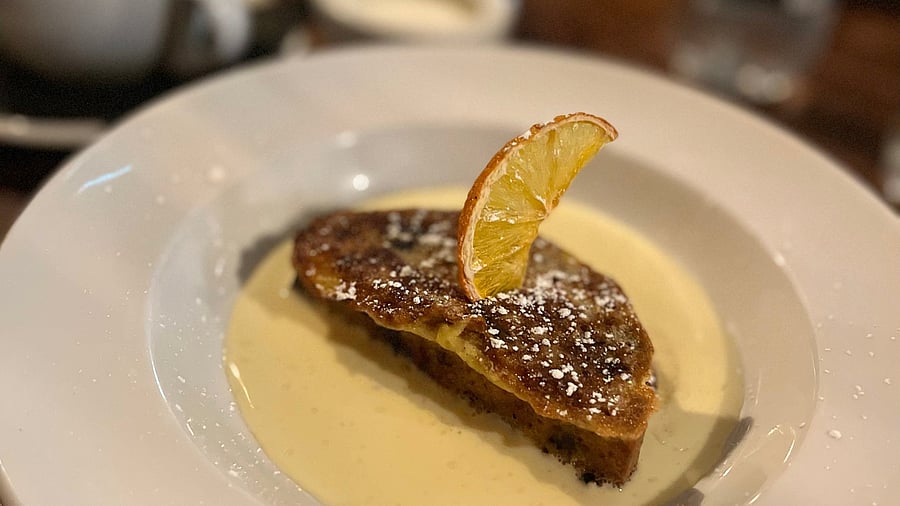
Bara brith.
Credit: Kshipra Bhat
Think cawl, faggots, laverbread and cockles and you immediately get transported to Welshland. The classic Welsh foodstuff is not the product of fancy gourmet meals, on the contrary, the dishes are prepared on humble fireplaces and cooked in a single large pot or baked on a bakestone with local ingredients reflecting the nation’s topography. So, on a recent food tour in Cardiff, an array of flavours and textures of traditional Welsh dishes took me by surprise.
The hearty, resourceful yet simple traditional Welsh food relies heavily on mutton, lamb, pork, beef and dairy from hillside pastures; leeks and cabbage from the farms; fishes such as brown trout from the rivers and streams and plentiful and hugely nutritious seaweed from Welsh beaches.
The thrifty Welsh fare has historically been made with simple local ingredients. This was to stoke up the hearty appetites of the mining community, fishermen and peasants.
Signature dishes
Cawl, the warm flavourful stew is a winter staple and became my comfort food while I was in Wales. Invented in the 14th century, it was traditionally prepared in a pot over an open fire and usually served during winter months, festivities and special occasions. The most traditional version of the stew includes Welsh favourites — lamb and leeks. Recipes differ from region to region, family to family, but the imperative is that all ingredients tossed together must be cooked thoroughly until the flavours are completely infused.
I was later bowled over by another Welsh dish named ‘faggots’. Although the word is branded offensive, here, faggots are meatballs. The name comes from an old British term ‘a bundle of sticks bound together as fuel’ — refers to the way the meatballs are shaped, wrapped with caul fat and baked. Faggots are typically made of minced pork offal such as heart, liver or spleen mixed with onions, sage or parsley and breadcrumbs. While I ate faggots with thick gravy and mushy peas — this is how they are usually served, I couldn’t finish off the whole portion given the firm and heavy texture of meatballs and the thick gravy.
I soon moved my attention to the unique laverbread which has little to do with bread, albeit I was hoping to see some sort of paste on a slice of bread alongside cockles. A type of seaweed known as ‘laver’ is boiled for several hours, chopped and puréed into a soft, smooth paste known as ‘laverbread’ (‘bara lawr’ in Welsh). It is often served with a Welsh breakfast alongside another delicacy, of course, Welsh cockles. Welsh cockles. Welsh sausages and bacon, mushrooms and eggs traditionally accompany both. The combination of laverbread and cockles sprayed with some vinegar for an extra Welsh twist wins the title of my most distinctive food from Wales.
Meanwhile, Glamorgan sausages which don’t contain any meat at all and caws pobi, the medieval precursor to Welsh rarebit (the dish seems to be the humble cheese on toast but it’s much more than that) are some of the other dishes which are part of the Welsh food culture.
Glamorgan Sausages, the cheesy, veggie croquettes made with breadcrumbs, are named after the historic county of Glamorgan. They became popular during World War II when meat was hard to come by. They are mostly made with tangy Caerphilly or cheddar cheese these days.
On the other hand, “Welsh rarebit is a posh cheese on toast,” adds Sian Roberts an expert on Welsh food. “Traditionally, all the ingredients were put in the oven until they melted and then eaten with bread — like a fondue. Today, you put all the ingredients in a saucepan, melt them until they form a thick paste and then spread onto some toasted bread and grill,” adds Roberts. The old-fashioned version comprises a roux mixed with ale or cider, Worcestershire sauce, mustard, butter dab, and Welsh cheddar.
Sweet treats
Taking my sweet moments in Wales to another level was the warm delightful Welsh cake. These durable little disc-shaped treats once provided Welsh coal miners with the perfect sugar boost. They are made with butter or lard mixed with flour and sugar, bound with egg or milk, punctuated with sweet currant and laced with a wonderful hint of mace, cinnamon or nutmeg. Traditionally cooked on a bakestone for about two minutes on each side and dusted with sugar. They are crispy on the outside and soft and moist on the inside and are simply irresistible!
While I don’t particularly have a sweet tooth, the sweetness of bara brith still lingers in my mouth. The name bara brith translates as ‘speckled bread’ or ‘mottled bread’ and is usually served with salted butter.
It’s a Welsh tea bread flavoured with tea, dried fruits and spices. In my case, I preferred to savour my bara brith with a modern twist. So, I was served bara brith with a dollop of custard, instead of butter, followed by a warm cup of local coffee at a restaurant in Cardiff. And then just like that, my Welsh culinary sojourn was coming to an end leaving me wanting to taste more.